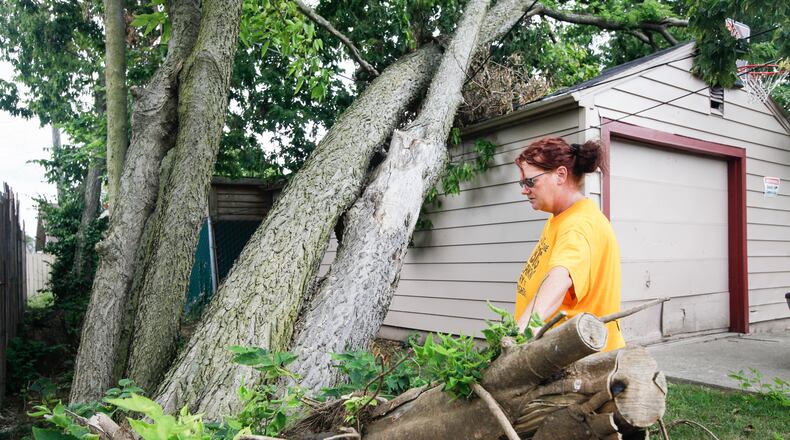“Some of it is hanging pretty precariously over homes and garages and outbuildings,” said Laura Mercer, who is leading the area’s individual recovery effort. “Some of it is just giant stuff that fell … but no normal human being is going to be able to move it.”
INTERACTIVE MAP: See where thousands of properties were damaged in Montgomery County tornadoes
In most cases, homeowner’s insurance will not pay for removal of downed trees unless the tree landed on an insured structure. FEMA grants, likewise, can’t be put toward tree removal, Sally Dyer of Presbyterian Disaster Assistance said.
“It’s not cheap,” Dyer said. “This is a long-term challenge to our community … People don’t have thousands and thousands of dollars – especially when they are trying to fix their house up and be able to live comfortably again.”
Dyer watched a crisis cleanup map expand to 611 cases, but 275 jobs dealing with big trees or parts of trees were too much for volunteer groups.
“Sadly, a lot of these jobs are bigger than their ability to do it safely,” she said.
While large tree debris is not the most pressing hurdle toward rebuilding neighborhoods, Mercer said without removal, recovery could drag.
“I think it will dampen the community’s ability to recover in that nobody necessarily wants to buy a house or move into a neighborhood that looks like the storm just went through,” she said.
A large tree leans alarmingly over a power line and Nicole Sapp’s garage behind her Brandt Street home in Dayton. Sapp and her husband David got bids to have it removed, but the lowest at $2,000 is more than the family of six can afford right now, she said.
“It’s just going to sit there. I don’t know what to do with it,” she said.
MORE: Local tornado victims slow to get FEMA aid approval
The family was without electricity for five days after the storm, and if the tree drops several more inches, they could be without power again, Sapp said.
“Right now, it’s not bothering nothing until it finishes falling,” she said.
Sapp called the crisis cleanup hotline to report the tree and another cluster it dragged down with it. But like the other unclaimed tickets on Dyer’s map, the job at the Sapp house is too much for ordinary volunteers.
“People have gone out and looked at them, but they are way beyond the scope of church volunteer groups,” Dyer said.
MORE: $5M in disaster grants lift tornado recovery efforts
Scott Sliver organized tornado cleanups in Beavercreek, where he is associate pastor of the Vineyard Church. He estimates over 10 weeks they removed more than 60,000 pounds of debris, but there was plenty of debris they just couldn’t handle.
“Most of what’s left now is too big for us … you have to have heavy equipment,” Sliver said. “There are limits to what volunteers can do.”
Sliver said some property owners in Beavercreek lost numerous trees, now lopped anywhere from two to eight feet off the ground.
“I’m guessing they are going to stay that way for a while,” he said. “The costs are just enormous.”
It remains unclear how the remaining large tree debris will be removed — if ever.
Mercer said the area’s long-term recovery operations group is looking to again enlist the help of Team Rubicon, a nonprofit made up of military veterans that was on the ground for about 20 days directly following the storm working to clear debris.
Team Rubicon plans to send volunteers back to Miami Valley on Sept. 14 to assist local groups during a community cleanup event, said DJ Sprenger, a Team Rubicon spokesman. Headquartered in Los Angeles, the organization has 65,000-plus volunteers across the country.
“We’ll do everything we can to help citizens within our scope of service,” he said.
MORE: Tornadoes have hundreds of households struggling for housing
While Team Rubicon will be here with chainsaws, crews won’t be bringing heavy equipment, Sprenger said.
Without a plan to bring in heavy machinery, the buried stumps and beefy trunks threaten to become an unsightly part of the permanent landscape.
“They are just not magically going to go away,” Dyer said. “I wish I knew what the solution was, but I don’t.”
Crisis cleanup hotline
A home cleanup hotline for trees and debris cleanup is available to property owners affected by Memorial Dayt tornadoes. Registering will allow volunteers to see your request for assistance, but the free service is dependent on the availability of volunteer labor and difficulty. The hotline will be available through Friday. If you are emailing a request, please attach a photo of the work needed. A volunteer will call you back within 48 hours to get more detailed information.
Email: MVCrisisCleanup@gmail.com
Phone: 937-512-5700
Volunteer for community cleanup
Sept. 14
8:30 a.m. to 3 p.m.
Help clean up debris at one of three locations, Old North Dayton, Harrison Twp. or Trotwood. Visit MVStrong.org and click on volunteer tab to volunteer sign up page.
FEMA DEADLINES
Recovery center to close Friday
The area’s last disaster recovery center at Dayton Children’s Hospital Child Health Pavilion will be open 10 a.m. to 7 p.m. daily through the end of Friday.
Sept. 3 last day to register with FEMA
Homeowners and renters with tornado-related losses have one week remaining to register for FEMA assistance.
Online: www.DisasterAssistance.gov
Mobile device: FEMA App
Phone: 800-621-3362 (including 711 or Video Relay). TTY users can call 800-462-7585. The toll-free numbers are open from 7 a.m. to 9 p.m. daily. Multilingual operators are available.
About the Author

